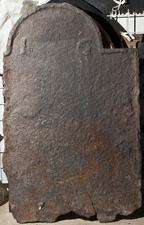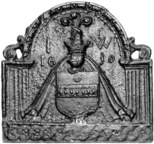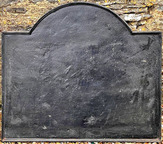-
689
Description: Rectangular with pediment; ovolo moulded edging inside top of pediment and inside top and sides of rectangle; centre top, four-petal rose and crown with three fleurs-de-lys below; at either end, stamps made from two parts of a wreath (the middle section missing); in the pediment a cross.
Notes: The wreaths from which the stamps have been disassembled can be seen complete on two other firebacks, and the rose and crown is a common stamp on a large series of early firebacks.
Inscription: I T
- Decoration tags:
- triangular arched (shape)
- cavetto (edging)
- carved stamps
- individual letters
- heraldic
- royal
- text
- objects
Manufactured: in the late-16th century in the Weald area of England.
Current location: in private hands, Slaugham, West Sussex, England.
- Attached to series:
- Royal series
- Royal (wreath) series
-
1094
Description: Rectangular; twisted rope edging (top and sides); top centre, crowned Tudor royal shield between a lion passant on the right and a lion passant guardant sinister on the left; in each top corner a crowned four-petal rose, below which, to the right, a left-facing 'imp' with both arms lowered; below the armorial, a crowned shield bearing initials, KH, in Lombardic lettering, above a fleur-de-lys; a much-corroded imp figure may be below the right-hand lion.
Notes: A heavily corroded variant of a type bearing Henrician heraldic elements.
Arms: Tudor royal arms of England
- Decoration tags:
- rectangular (shape)
- rope (edging)
- carved stamps
- heraldic
- armorial
- animals
- humans
Manufactured: in the mid-16th century in the Weald area of England.
Current location: Smallhythe Place, Small Hythe Road, Tenterden, Kent, England.
Museum number: 1117950 (part of the National Trust museum group)
- Attached to series:
- Royal series
-
690
Description: Canted rectangle; plain edges; broad horizontal fillet dividing the plate in two just above the side angles, with vertical fillets to top corners enclosing date and initials.
Notes: Uncharacteristically crude for the period.
Inscription: IS / 16 60
- Decoration tags:
- rectangular with canted top corners (shape)
- none (edging)
- simple stamps
- individual letters
- individual numbers
- text
Manufactured: in 1660 in the Weald area of England.
Current location: Smallhythe Place, Small Hythe Road, Tenterden, Kent, England.
Museum number: 1117951 (part of the National Trust museum group)
- Attached to series:
- Date & initials firebacks
-
892
Description: Canted rectangular shape; plain edging with inset ?leather strap twisted round dowel (top and sides); top centre, date probably in stamped numerals; twisted leather strap saltire repeated three times across middle of plate; pair of stamped initials, formed of a Roman 'W' and a Gothic 'd', above each outer saltire.
Notes: Sotheby's sale London 27 November 2006, lot 324; formerly at Brunger, Kent (near Tenterden).
Inscription: 1610 / WD WD
- Decoration tags:
- rectangular with canted top corners (shape)
- none (edging)
- simple stamps
- individual letters
- individual numbers
- apotropaic
- text
- objects
Manufactured: in 1610 in England.
Current location: not known.
- Attached to series:
- Date & initials firebacks
- Miscellaneous stamp firebacks
-
1143
Description: Fragment, left side missing; arched rectangular shape; fillet edging (top and sides visible); initials IG widely spaced in arch.
Notes: Previously at Bream Court Farm, Newland, Gloucestershire.
Inscription: I G
- Decoration tags:
- rectangular with round arch (shape)
- fillet (edging)
- simple stamps
- individual letters
- text
Manufactured: in the 17th century possibly in the Forest of Dean area of England.
Current location: Dean Heritage Centre, Camp Mill, Soudley, Gloucestershire, England.
- Attached to series:
- Initials only firebacks
-
691
Description: Arched rectangle; arch with egg and dart, ovolo edging, resting on rectangle shoulders and sides with triple fillet edging, a single fillet edged panel beneath; bottom panel, guilloche pattern of 12; main panel: shield, helm, crest, coronet and mantling of the Wynter/Wintour family of Lydney, Gloucestershire; the initials above the date, both split by the helm and coronet; on either side of the shield, Ionic pilasters; above the rectangle shoulders, a scrolled bracket each side, supporting the arch.
Notes: Wynter: Sable, a fess ermine, in chief a crescent for difference; crest: out of a ducal coronet, or, a cubit arm in armour erect, proper, garnished of the first, in the gauntlet three ostrich-feathers. The arms are likely to be those of Sir John Wynter, who owned several furnaces in the Forest of Dean. Formerly at Watts House, Bishop's Lydeard, Somerset, and before that at The Priory, Taunton.
Inscription: I W / 16 30
Arms: Winter/Wintour of Lydney, Gloucestershire
- Decoration tags:
- rectangular with round arch (shape)
- ovolo, egg and dart (edging)
- whole carved pattern
- individual letters
- individual numbers
- armorial
- text
Manufactured: in 1630 in the Forest of Dean area of England.
Current location: Horniman Museum, 100 London Road, Forest Hill, London, England.
Museum number: 6.249 (part of the Horniman Museum museum group)
- Attached to series:
- Personal armorial firebacks
- Date & initials firebacks
-
903
Description: Rectangular; ovolo-moulded edging (top and sides); date between split initials across upper half of plate; two notches cut away for insertion of firedogs.
Notes: The ‘6s’ appear to have been moulded from a type of jemmy.
Inscription: g 1669 P [reversed]
- Decoration tags:
- rectangular (shape)
- ovolo (edging)
- simple stamps
- carved stamps
- individual letters
- individual numbers
- text
- objects
Manufactured: in 1669 possibly in the Weald area of England.
Current location: George & Dragon Inn, Speldhurst Hill, Speldhurst, Kent, England.
-
1245
Description: Arched rectangular shape; cavetto-moulded edging; no decoration.
Notes: A plain base board.
- Decoration tags:
- rectangular with round arch (shape)
- cavetto (edging)
- whole carved pattern
Manufactured: in England.
Current location: not known.
- Attached to series:
- Base boards
-
959
Description: Arched shape; twisted rope edging (top and sides); top centre, shield of impaled arms; date above shield; initials, in triad ('F above), to right of shield.
Notes: The arms are of Sir Peter Frecheville (1575-1634) of Staveley Hall, Derbyshire, and his first wife, Joyce Osborne, née Fleetwood (d.1619), whom he had married in the year of the fireback's casting; the blazon is as follows: (Frecheville) Azure, a bend between six escallops argent; (Fleetwood) Per pale nebuly or and azure, six martlets, two, two and two counterchanged (the tinctures, as painted, are incorrect). At the bottom of the fireback there appears to be the remains of a runner by which the molten iron flowed into the sand mould.
Inscription: 1605 / PFI [triad]
Arms: Frecheville impaling Fleetwood
- Decoration tags:
- rounded arched (shape)
- rope (edging)
- whole carved pattern
- individual letters
- individual numbers
- armorial
- text
Manufactured: in 1605 probably at Staveley Furnace in the Derbyshire area of England.
Current location: Staveley Hall, Staveley Hall Drive, Staveley, Derbyshire, England.
- Attached to series:
- Personal armorial firebacks
- Date & initials firebacks
-
692
Description: Rectangular with inclined sides, joined by scrolls to a pedimented top; twisted rope edging (top and sides); Garter enclosing the Tudor royal arms, with crowned lion and dragon supporters, helm with chapeau and lion crest, and mantling; rectangular date compartment at base; initials either side of crest.
Notes: The detached pediment is stylistically typical of the late-16th and early-17th centuries. The use of a chapeau or cap of maintenance in place of a crown above the helm is rare in this period. There is an excrescence on the casting over the jaws of the dragon caused by the pouring of the molten metal disturbing the sand mould.
Inscription: E R / Garter motto / 160[?0]
Arms: Tudor royal - Elizabeth I
- Decoration tags:
- rectangular with detached pediment (shape)
- rope (edging)
- whole carved pattern
- individual letters
- individual numbers
- armorial
- royal
- text
Manufactured: in 1600 in England.
Current location: Cothay Manor, Stawley, Somerset, England.
- Attached to series:
- Elizabethan royal armorial firebacks
- Tudor royal armorial firebacks









